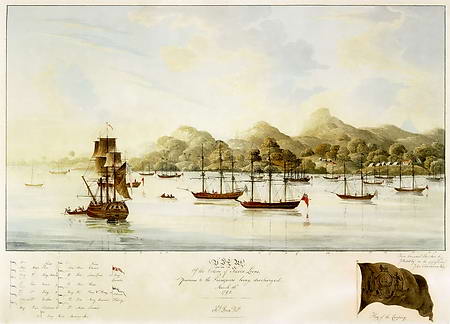Written by Dan Conlin,
Curator of Marine Heritage, Maritime Museum of the Atlantic, Halifax, NS
Thursday, 24 July 2008

"View of the Colony of Sierra Leone Previous to the Transports Being Discharged, March 16, 1792"
This painting has become a key iconic image of the Black Loyalist and Sierra Leone experience.
The painting is of outstanding significance on several levels. It is foremost a rare and accurate eyewitness view of a pivotal moment in history, the return of Africans freed from North American slavery to Africa by a fleet of Nova Scotian vessels. This voyage from Nova Scotia marked a major international event in the campaign against the slave trade as it was the first large-scale return of freed slaves to African. The venture was a major early project of the growing abolitionist movement in Britain and its colonies. The fleet was led by abolitionist and naval officer John Clarkson, brother to the famous abolitionist Thomas Clarkson. It is the only known painting of which shows the arrival of the Nova Scotia ships which marked the founding of the city of Freetown and the nation of Sierra Leone.
The escaped slaves known as the Black Loyalists were a major part of the Loyalist Settlement in the region after the American Revolution. While the Maritimes provided freedom, it did not provide equality for many Black Loyalists who were given poor land and far less assistance than White Loyalists. A delegation of Africans from Nova Scotia joined forces with abolitionists to provide the core of settlement for the new colony of Sierra Leone. The fleet shown in this painting overcame hostile colonial officials and severe storms to take 1200 Africans from Nova Scotia to Africa. Sickness and weather claimed 65 lives but the fleet held together and a remarkably harmonious shipboard society was established for the voyage designed to give equality and responsibility to the Africans aboard, in deliberate contrast to the hellish oppression of the slave ships experienced by many earlier in their lives. A “black captain” was selected from the African passengers aboard each ship to safeguard supplies and represent their concerns to the ship captain. The painting is prominently featured and discussed in Simon Schama's recent book Rough Crossings: Britain, the Slaves, and the American Revolution. In fact Schama argues that the fleet was a unique experiment in the human history and in no danger of being confused with a slaving expedition, neither would it quite resemble any other kind of sailing - naval or mercantile. What John Clarkson had designed was an inter-racial, floating Christian republic; bound for freedom ... an experimental voyage of social transformation because no distinctions would be tolerated between Blacks and Whites... The settlers from Nova Scotia marked the beginning of the colony, after a disastrous attempt five years earlier by white settlers and a small number of former slaves from London. The Africans from Nova Scotia would form the key middle class of the colony and later state of Sierra Leone and would be known for generations as “The Nova Scotians”.
This watercolour shows the critical founding moment of Freetown as the Nova Scotian fleet has completed the disembarkation of the free Africans. The first vessels of the fleet had arrived on March 7, 1792. The next 10 days were spent unloading passengers and supplies. On the day of this painting, the last of the supplies had been landed and Clarkson provide a special dinner of roast turtle under a tent to express his thanks. The next day Clarkson “discharged” the ships, that is released them to return to Nova Scotia. |